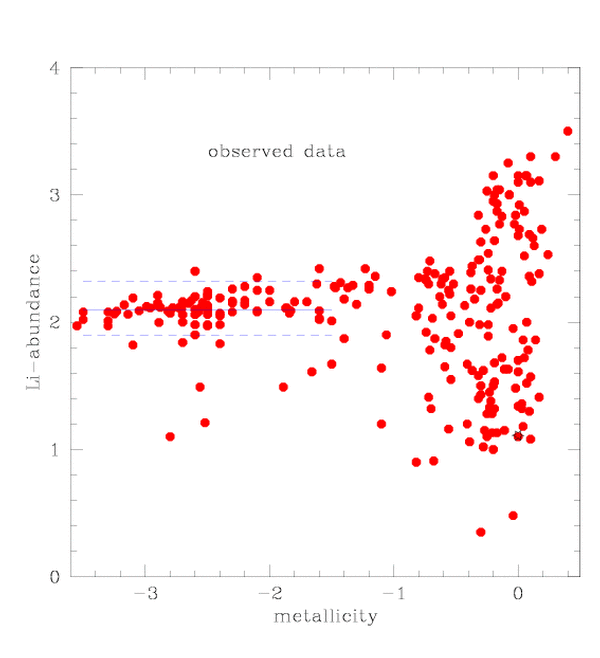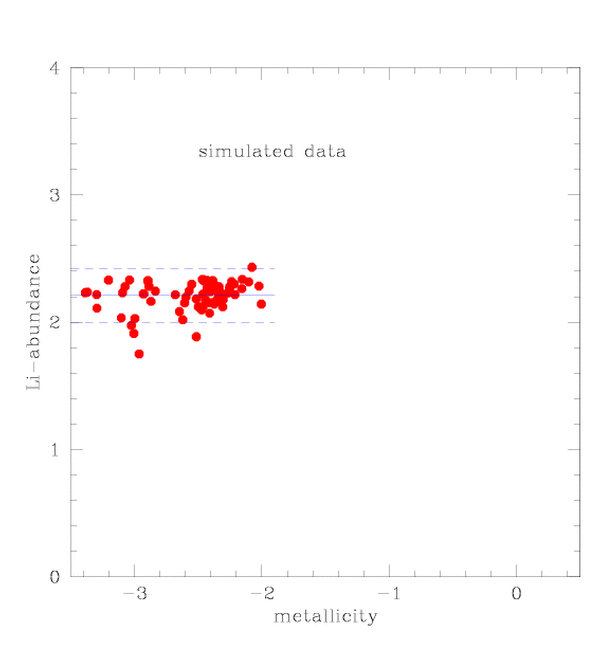Old stars telling about the Big Bang |
Combining observations of very old stars and the most refined stellar evolution calculations, researchers at the Max-Planck-Institute for Astrophysics have achieved to determine the production of Lithium in the Big Bang, from which the cosmological density of ordinary matter can be infered.
Lithium (more exactly: its isotope 7Li with 3 protons and 4 neutrons making up the nucleus) is the heaviest element (besides hydrogen and helium isotopes) that is created in notable amounts in the Big Bang, that is at the very beginning of the Universe. How much of each of these primordial elements was created, depends on the density of ordinary matter (at this point, neutrons and protons) in the universe. One can determine this "cosmological baryon density" if one can find out the primordial abundances of deuterium (heavy hydrogen), helium, and lithium. But where is the place to find this in a Universe 14 billion years old and in which all chemical elements are subject to creation and destruction in stars?

|
| Figure 1: Observed 7Lithium abundances in galactic stars as a function of metal content. The abundance is given in a logarthmic scale, where, for example, a value of 2 resp. 3 means that 100 resp. 1000 7Li atoms are present for each 1012 hydrogen atoms. The metallicity scale is logarithmic, too, and gives the iron content relative to that in the Sun. The Sun (marked by the star) is therefore at a value of 0 per definition and the most metal-poor stars at -3 have only 1/1000 of the solar metal content. The observational data are from several sources and were kindly provided by Dr. S.G. Ryan (The Open University, Milton Keynes, England). The mean value of the Lithium-plateau is indicated by the solid blue line, the dashed lines indicate the variation around it. |
Figure 1 shows observations of 7Li in galactic stars as a function of total "metal content", which is cosidered as the amount of all elements except hydrogen and helium. Roughly, the metallicity scale corresponds to a stellar age scale: the oldest stars have the lowest metallicity (to the left of the figure), "recently" born stars the highest (to the right, where also the position of the Sun is indicated). On the right side a huge spread of the Lithium abundance is visible. This is the result of many nuclear processes in stars leading to the destruction and creation of 7Li.
Therefore it is even more notable that in the left part of the figure a constant Lithium value is achieved with only a very small scatter around the mean value. The straightforward interpretation of this "Lithium-plateau" is that it represents the primordial abundance of Lithium. This is supported by the fact that the stars on the plateau are very metal-poor and thus very old. Indeed, they are the oldest objects in our Galaxy and have formed not long after the Big Bang. The value for the 7Li abundance of the plateau corresponds to a certain baryon content of the universe. This value is lower than that necessary to produce the independently measured primordial deuterium abundance. And it is even lower than that infered from the cosmic microwave background (see highlight of August, 2000). How can we resolve this discrepancy?

|
| Figure 2: As Figure 1, but this time the 7Lithium abundance is obtained from the theoretical models. Shown are about 60 stars of low metal content as would be observed in a typical observational campaign. Again, mean value and spread are indicated by the blue lines. The plateau-like structure is obivous, but there are a few stars below it, in which sedimentation has led to significant depletion. Comparing with Figure 1, one realizes that in the observations, too, there are such outliers. |
The problem was tackled by M. Salaris (Liverpool John Moores University and MPA) and A. Weiss (MPA). They used the most up-to-date stellar models representing the stars on the Lithium-plateau. The physics treated in these models includes the effect of sedimentation, i.e. the sinking of heavier elements towards the centre of a star. This leads to a depletion of 7Li from the surface, but the effect varies from star to star due to different mass, composition, age. From the models the authors produced simulated observations (see Figure 2) and could show that -- given present properties of the observations - the surface Lithium depletion is almost constant for all stars, such that the plateau-like structure is preserved. Only at the most metal-poor end of Figure 2 a few stars strongly depleted show up - just as is found in real observations. The authors also predict that with samples of about 200 stars the variation of the depletion from star to star should become clearly visible, and the plateau should disappear.
From the 7Li depletion in the theoretical models and the observed 7Li abundance in the plateau one can calculate back to the true primordial value, which is about twice as large as that of the plateau. This corresponds to a baryon density that is exactly the one also deduced from the deuterium measurements and in addition is in agreement with some determinations of the primordial helium content. It is also well within the range allowed by the most recent analysis of cosmic microwave background measurements. The new models can therefore resolve the discrepant results of the different determinations of the matter density in the Universe.
Old stars in our Galaxy together with new stellar models thus yield valuable information about the conditions in the Big Bang and about the composition of matter in the Universe.
Comments to: Achim Weiss (aweiss at this domain)
Further information:
| MPA-Home |